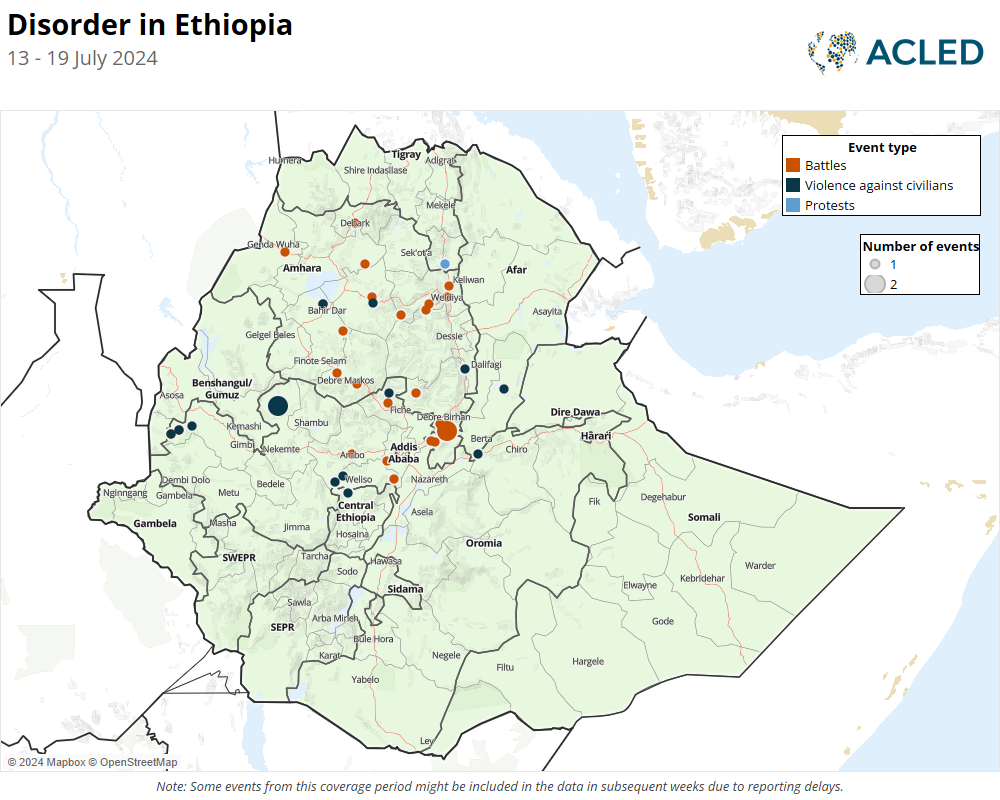Situation summary
Displaced persons continue to return to contested territory in Southern Tigray zone in Tigray amid protests. Meanwhile, clashes and violence targeting civilians were reported in Amhara and Oromia regions.
Unrest in Amhara region impacts Sudanese refugees
Fano militias and government forces continued clashing throughout last week, with fighting recorded in North Shewa, North and South Wello, East and West Gojam, North, Central, South, and West Gondar zones. Reports of major armed clashes between Fano militias and Kebele militias in Ykaho Kebele in Quara woreda, West Gondar zone, emerged last week. The clash began on 5 July and continued for four consecutive days. According to local officials, clashes were sparked after Fano militias asked Kebele militias, mostly ethnic Agew, to hand over weapons and stop supporting the government.1BBC Amharic, ‘It was reported that many people were killed and 10,000 were displaced in an attack by ‘Fano militants’ in West Gondar Qara,’ 19 July 2024 Following the Kebele militia’s refusal to disarm, fighting continued until Fano militias took control of the area on 9 July. It is unclear how many people were killed in the clashes. However, the administrator of the Ykaho Kebele reported over 80 civilians were killed in the fighting, and thousands of people fled the area, fearing additional violence.2BBC Amharic, ‘It was reported that many people were killed and 10,000 were displaced in an attack by ‘Fano militants’ in West Gondar Qara,’ 19 July 2024 Clashes between Qemant ethnic militias, Fano militias, Amhara regional special forces, and local Kebele militias emerged before and continued during the northern Ethiopia conflict over demands for greater autonomy for the Qemant ethnic group (a subset of the Agew ethnic group).
Elsewhere, unidentified armed men, likely members of Fano militias, attacked a security outpost at the Kumer refugee camp hosting Sudanese refugees in West Gondar zone on 17 July. The attack reportedly killed at least nine federal police officers and injured an unknown number of refugees, including a refugee child. The event was one of the most deadly incidents to occur in the vicinity of the camp, highlighting the dangers that Sudanese refugees face in Ethiopia. Violence targeting Sudanese refugees sparked large protests in camps near the border since May, and similar incidents have occurred frequently. The Ethiopian government and the United Nations High Commissioner for Refugees announced a new site for refugees, called ‘Aftet,’ to which they plan to move a majority of refugees currently in Awlala and Kumer camps for improved security.3Alemnew Mekonen, Azeb Tadese and Eshete Bekele, ‘The killing of refugees and the new shelter in Matema,’ DW Amharic, 22 July 2024
Civilians face targeted violence in Oromia region
Like in Amhara region, civilians continued to be caught in the crossfire of fighting between the Oromo Liberation Army (OLA) — referred to by the government as the Oromo Liberation Front (OLF)-Shane — and the Ethiopian National Defense Force (ENDF) last week. Clashes were reported in North Shewa, West Wollega, South West Shewa, and West Shewa zones and the Sheger city area. In Begi woreda in West Wollega zone, government forces reportedly shot and killed two young men on 15 July after accusing them of supporting the OLA/OLF-Shane. The next day, a third young man was similarly killed in Gudetu Kondole woreda, West Wollega zone.
Fano militias were also accused of attacking civilians in Oromia region. On 15 July, Fano militias carried out attacks on civilians in Abuye Jabilal Kebele in Ameya woreda, Southwest Shewa zone, killing at least nine civilians and injuring three others. The next day, the members of the militias also shot and killed three civilians in Jiru Dada Kebele in Dera woreda, North Shewa zone.
Internally displaced people continue to return to their residence in Tigray amid Protests
In Tigray region, over 10,000 internally displaced people returned to Alamata town in Southern Tigray zone from camps in Mehoni (around 45 kilometers to the north of the town). This sparked a two-day protest from ethnic Amhara residents in the city who accused the returnees of including armed members of the Tigray Defence Forces.4Mulugeta Belay, ‘Residents who say “armed forces are entering” Alamata city; Protests were held yesterday and today,’ Ethiopian Insider, 18 July 2024; Mesfen Arage ‘Those displayed due to conflict are returning to Raya Alamata and the surrounding area,’ VOA Amharic, 19 February 2024 The town of Alamata lies within an area of contested territory claimed by both Amhara and Tigray regions. Internally displaced Tigrayans began returning to their residences in early July.
Tensions in Alamata and its environs have been high for months. Clashes between elements from Tigray and Amhara regions in the vicinity of Alamata began in February, threatening the Pretoria peace agreement. Clashes continued and expanded in the area in April, followed by a heavy deployment of the ENDF to the city. On 4 July, the federal government ordered Tigray forces to withdraw from the area, which had been under the control of a defacto Amhara administration during the northern Ethiopia conflict.

Ethiopia at a Glance
13-19 July 2024
The data cover the period from 13 to 19 July 2024. For more information about how ACLED collects data and categorizes events, see the ACLED Codebook. Some events from this coverage period might be included in the data in subsequent weeks due to reporting delays.
Political Violence Events5This includes the Battles, Explosions/Remote violence and Violence against civilians event types, as well as the Mob violence sub-event type of the Riots event type.: 40
-24% from previous week
Demonstration Events6This includes the Protests event type as well as the Violent demonstrations sub-event type of the Riots event type.: 1
-50% from previous week
Event Types
Battles: 26 Events
Explosions/Remote Violence: 0 Event
Violence Against Civilians: 14 Events
Mob Violence: 0 Event
Protests: 1 Event
Violent Demonstrations: 0 Event





